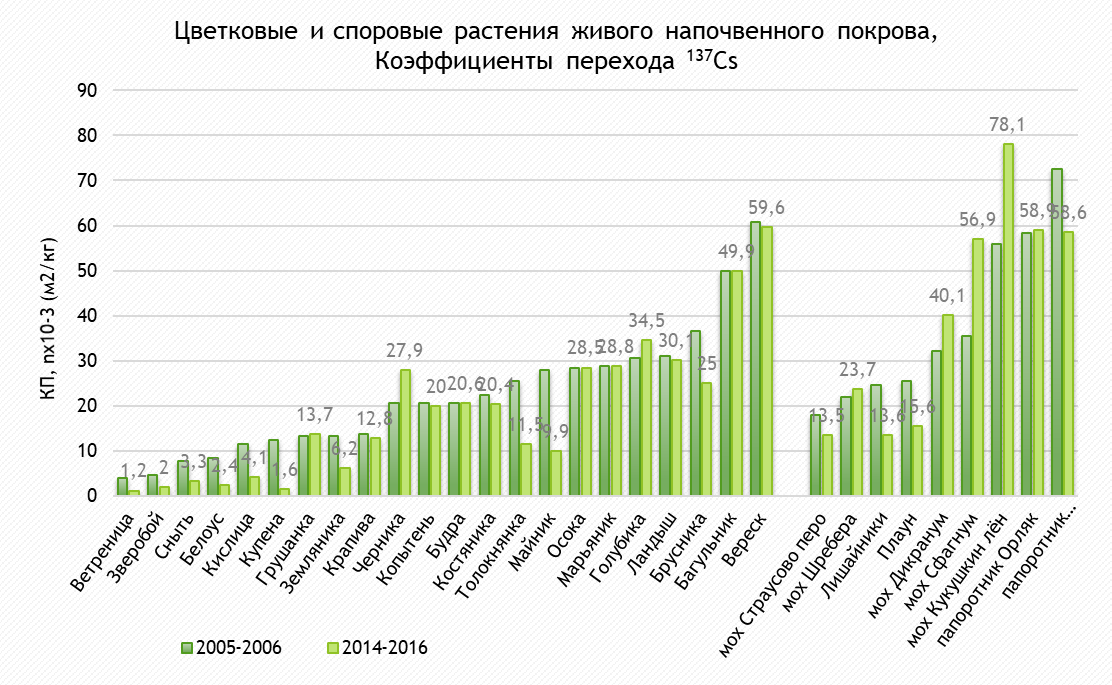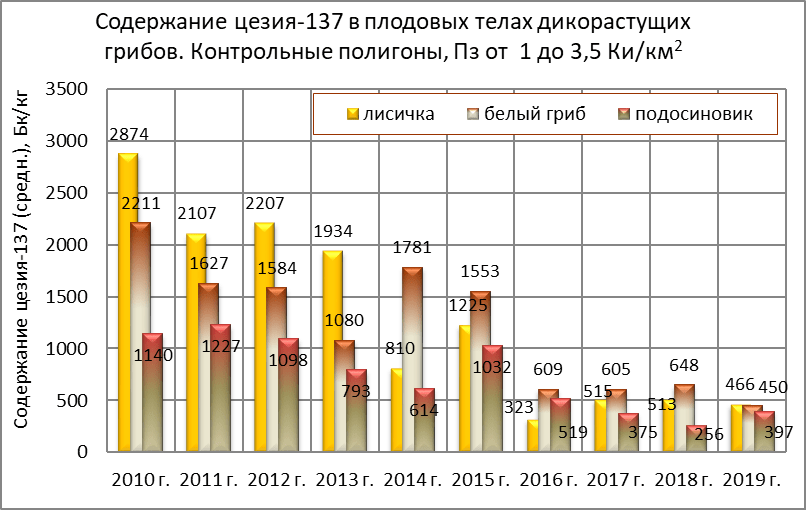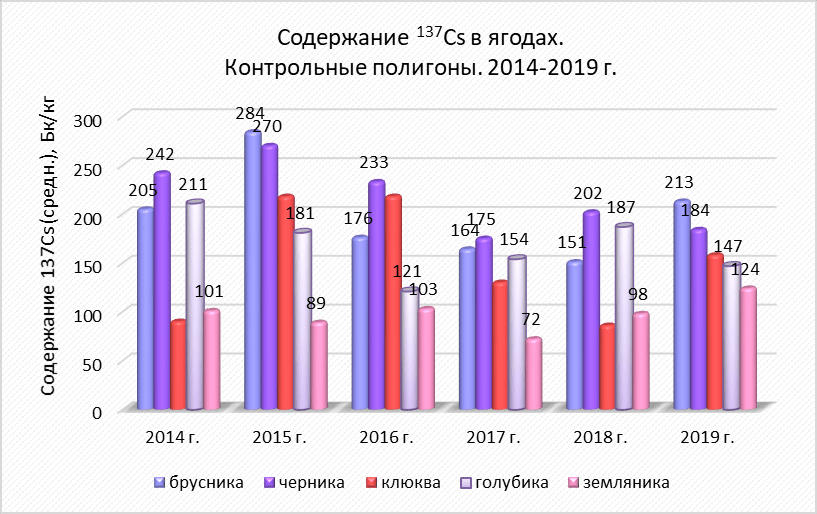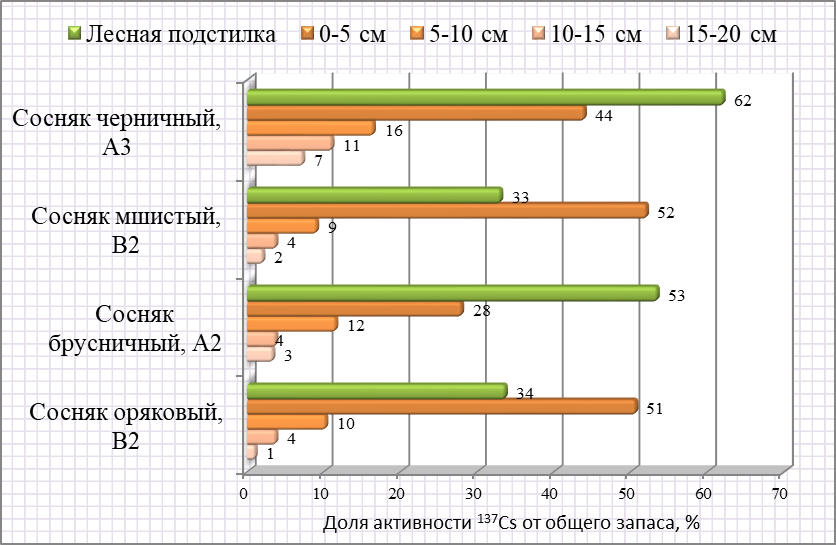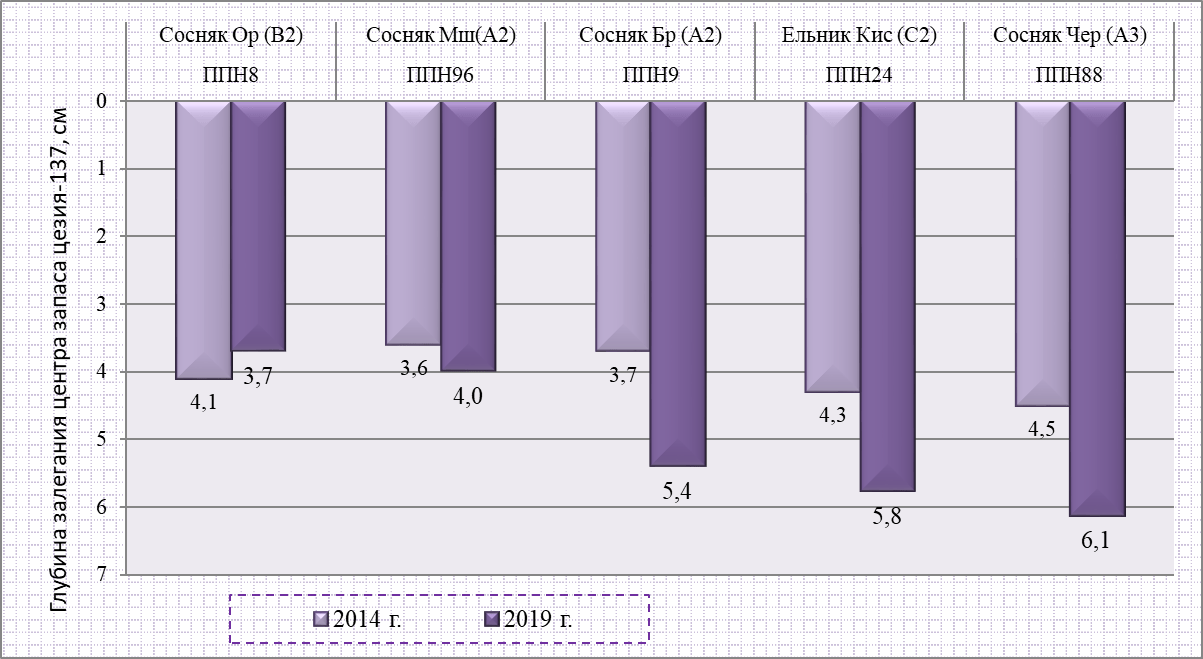Dynamics of wood pollution
To assess the intensity of transition of cesium-137 from soil to wood and its parts, to plants of living soil cover, mushrooms use an indicator – conversion coefficient (KP, nх10-3, m2 / kg).
At permanent observation points (PPS), bark samples with bast, wood, branches, needles or leaves are taken from model trees of the main tier, branches are taken from undergrowth trees and from undergrowth species. Cesium-137 content is measured in monitoring objects, content levels, transition coefficients, and their change with time are analyzed. In the system of the Ministry of Forestry, 44 PPN are examined at a frequency of once every five years. At all PPNs, the content of cesium-137 in the wood of the main forest-forming species is reduced, and the intensity of the transition of cesium-137 from soil to wood is reduced. The decrease in the intake of cesium-137 in vegetation is explained by its stable and bound state in the soil, a decrease in solubility and, as a result, accessibility (less than 3-4%) in the nutrient chain: soil – plant.
A comparison of the results of radiation monitoring of wood, selected during the survey of cutting areas in 2010 and 2019, shows that the annual rate of decrease in cesium-137 activity in wood is from 1.8 to 2.35%.
Change MD
On PPN, the dose rate of gamma radiation is monitored along its perimeter and in the places of soil sampling, in only 20 points. According to the results of measurements of the dose rate at the PPN, as well as during the radio-ion survey of forest areas, there is a steady downward trend in this indicator over time. The dose rate in the forest fund decreases on average to 2.2% per year as the density of soil contamination with cesium-137 decreases, the radionuclide moves inward along the soil profile, and its redistribution along the components of forest biocenoses.
In a significant part (95%) of the territory of radioactive contamination during forestry operations, compliance with radiation safety standards was ensured, without exceeding the limit of the average annual radiation dose of 1 mSv. According to the results of a radiation survey in forest neighborhoods with a pollution density of less than 20 Ci / km2, the dose rate (average in the forest quarter) does not exceed 0.68 μSv / h – the value at which it is necessary to control external radiation doses by taking into account the duration of work.
KP mushrooms, berries
Over time, there is a decrease in the content of cesium-137 in the wood of undergrowth trees, undergrowth, as well as in ground cover plants, berries, and mushrooms. The maximum accumulation of the radionuclide is noted in ferns, mosses, as well as in the fruiting bodies of wild mushrooms, such as ring cap, russula, Polish mushroom, and moss fly. For these species, the cesium-137 (KP) transition coefficients exceed the value of 20×10-3 (m2 / kg).
When comparing the intensity of transition of cesium-137 into berries at control ranges (pollution density up to 5 Ci / km2) in different regions, higher KP values were observed in the territories of the forest fund of the forestries of the Brest GPLHO, the lowest – Grodno. The average KP values for the region do not change significantly – within the error of the measurement results.
Changes in the direction of decreasing the supply of cesium-137 to berries are more evident when analyzing the results of monitoring studies of the contamination of the same types of berries and mushrooms with cesium-137 at control sites.
The decrease in cesium-137 activity in wild berries and mushrooms occurs mainly due to natural natural processes – radioactive decay and, as a result, a decrease in cesium-137 activity in soil, forest litter, mycelium, as well as redistribution of the radionuclide among the components of the forest ecosystem. Other factors (growth conditions, seasonal weather conditions, productivity) also influence the processes of radionuclide entry into the fruiting bodies of mushrooms, therefore, when collecting mushrooms in areas exposed to radioactive contamination, forest management rules must be observed: collect mushrooms assigned to the groups of weakly and medium-accumulating radionuclides – honey agaric , umbrella, raincoat, porcini mushroom, boletus, chanterelle, boletus – with a pollution density of up to 2 Ci / km2 with mandatory radiometric monitoring.
Soil cesium migration
At the PPN of the industrial radiation monitoring network, the level of soil contamination with forest litter and live soil cover of cesium-137 is monitored, migration of the radionuclide to a depth of 20 cm is studied. In some types of forest (blueberry pine), more than 50% of the total cesium-137 reserve in forest soil is in forest litter and after more than 33 years after the Chernobyl accident. at the same time, over time, cesium-137 is released from the forest litter, it migrates to the mineral layers of the soil, while the most intensive transition to the mineral part of the soil occurs in plantations with a predominance of deciduous species – in pine forests of bracken and mossy. Radionuclides are less retained by forest litter with an increase in the proportion of deciduous undergrowth in the composition of plantations and a change in soil moisture conditions from automorphic (A2, B2) to hemihydromorphic (A3, B3).
Cesium-137 reserve distribution in forest litter, five-centimeter soil layers, 2019
Over the past 5 years, the processes of vertical migration of the cesium-137 radionuclide from the forest litter and the upper mineral soil layers to a great depth have been slowed down, especially in automorphic soil types, the center of the cesium-137 reserve has remained almost unchanged.




